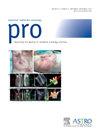Survival and Patterns of Relapse of Cutaneous Squamous Cell Carcinoma With Large Nerve Perineural Spread After Skull Base Surgery and/or Radiation Therapy
IF 3.4
3区 医学
Q2 ONCOLOGY
引用次数: 0
Abstract
Purpose
The aim of our study was to evaluate survival and patterns of relapse for patients with perineural spread (PNS) of cutaneous squamous cell carcinoma (cSCC), who have undergone curative intent skull base surgery and/or radiation therapy. In addition, we modified the classification of zone 2 disease into 2a and 2b and reported the respective outcome.
Methods and Materials
A review of a prospective database of patients who received diagnoses of PNS of cSCC and were treated with curative intent skull base surgery and/or radiation therapy between the years of 2013 and 2020 was conducted. Kaplan-Meier methods were used to estimate relapse-free survival (RFS), disease-specific survival (DSS), and overall survival (OS). Cox proportional hazard modeling was performed to test associations between patient factors and survival outcomes.
Results
Eighty patients with a median follow-up of 36 months were included in the study. The 5-year RFS was 61% (95% CI, 48%-71%), the DSS was 77% (95% CI, 63%-86%), and OS was 67% (95% CI, 53%-78%). In multivariable modeling, involvement of 2 or more nerves was strongly associated with worse 5-year RFS (HR, 4.0; P ≤ .001), DSS (HR, 4.5; P = .004), and OS (HR, 4.3; P = .002). Age group (≥65 years) (HR, 5.1; P = .010) and immune compromise (HR, 10.7; P = .001) were strongly associated with worse OS but not DSS or RFS. The majority of relapses (60%) occurred at the local skin sites.
Conclusions
Our study demonstrated surgery followed by radiation therapy was safe and effective in the management of cSCC with PNS. We did not detect a difference in outcome between zones 2a and 2b though further study is required. The most common mode of relapse was at the skin epidermis and/or adjacent dermis highlighting the importance of adequate local skin dose delivery.
颅底手术和/或放疗后伴有大神经周围神经扩散的皮肤鳞状细胞癌的存活率和复发模式
目的:我们的研究旨在评估已接受治愈性颅底手术和/或放疗的皮肤鳞状细胞癌(cSCC)神经周围扩散(PNS)患者的生存率和复发模式。此外,我们还将2区疾病的分类修改为2a和2b,并报告了各自的结果:我们对2013年至2020年期间接受治愈性颅底手术和/或放射治疗的cSCC PNS患者的前瞻性数据库进行了回顾性研究。研究采用卡普兰-梅耶法估算无复发生存期(RFS)、疾病特异性生存期(DSS)和总生存期(OS)。采用 Cox 比例危险模型检验患者因素与生存结果之间的关联:研究共纳入80名患者,中位随访时间为36个月。5年RFS为61%(95% CI,48%-71%),DSS为77%(95% CI,63%-86%),OS为67%(95% CI,53%-78%)。在多变量建模中,2条或更多神经受累与较差的5年RFS(HR,4.0;P≤ .001)、DSS(HR,4.5;P = .004)和OS(HR,4.3;P = .002)密切相关。年龄组(≥65 岁)(HR,5.1;P = .010)和免疫受损(HR,10.7;P = .001)与较差的 OS 密切相关,但与 DSS 或 RFS 无关。大多数复发(60%)发生在局部皮肤部位:我们的研究表明,在治疗伴有PNS的cSCC时,先手术后放疗是安全有效的。我们没有发现 2a 区和 2b 区的治疗效果有差异,但仍需进一步研究。最常见的复发部位是皮肤表皮和/或邻近的真皮层,这凸显了充分的局部皮肤剂量给药的重要性。
本文章由计算机程序翻译,如有差异,请以英文原文为准。
求助全文
约1分钟内获得全文
求助全文
来源期刊

Practical Radiation Oncology
Medicine-Radiology, Nuclear Medicine and Imaging
CiteScore
5.20
自引率
6.10%
发文量
177
审稿时长
34 days
期刊介绍:
The overarching mission of Practical Radiation Oncology is to improve the quality of radiation oncology practice. PRO''s purpose is to document the state of current practice, providing background for those in training and continuing education for practitioners, through discussion and illustration of new techniques, evaluation of current practices, and publication of case reports. PRO strives to provide its readers content that emphasizes knowledge "with a purpose." The content of PRO includes:
Original articles focusing on patient safety, quality measurement, or quality improvement initiatives
Original articles focusing on imaging, contouring, target delineation, simulation, treatment planning, immobilization, organ motion, and other practical issues
ASTRO guidelines, position papers, and consensus statements
Essays that highlight enriching personal experiences in caring for cancer patients and their families.
 求助内容:
求助内容: 应助结果提醒方式:
应助结果提醒方式:


